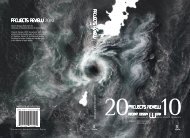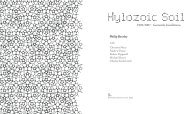The Inner Studio - Riverside Architectural Press
The Inner Studio - Riverside Architectural Press
The Inner Studio - Riverside Architectural Press
Create successful ePaper yourself
Turn your PDF publications into a flip-book with our unique Google optimized e-Paper software.
THE INNER STUDIO<br />
<strong>The</strong> part of us that is at the undeclared center of creativity is<br />
outside most architectural curriculum, and it may seem odd to<br />
suggest that self-knowledge needs to become an integral part of a<br />
designer’s education. But I find it very interesting that this undeclared<br />
inner world of the designer has always been covert and<br />
ignored in education. Schools make every investment in the outer<br />
world–becoming “wired,” striving for enhanced global information<br />
exchanges, competing for academic excellence–and all of these are<br />
important, but they do not begin to address the deeper strata of<br />
conscious and unconscious longings, needs, emotions, and desires<br />
that influence decision makers and affect decision making. I have<br />
come to believe that the idea of declaring the role played by the<br />
psyche in the creation of the built world is the best way to guide<br />
architectural know-how and heal the environment. <strong>The</strong> revolution<br />
I am imagining is one where we step back and consider that learning<br />
how to face design problems is critically important in learning<br />
how to solve them, where we consider that the how can not be<br />
separated from the what.<br />
While studying architecture in London, I often visited a public<br />
library on St. Martin’s Street where I would spend time, reading,<br />
drawing, daydreaming, and wandering through the rich collection<br />
of books and journals. <strong>The</strong>re was a modest scale to the three-story<br />
building and, sitting at a wooden desk in my favorite chair, I always<br />
felt comfortable, as though I was enjoying a stimulating conversation<br />
in the lobby of a small hotel. This was a library in which any<br />
idea could either be tracked back to its origins or projected into<br />
some future possibility.<br />
One day I stumbled across an essay in Art International called<br />
“Suicide and the Soul” by the American psychologist James<br />
Hillman. I began reading and soon found myself completely<br />
immersed in the world of the psyche he described. I read late into<br />
the evening and returned to the library in the morning to finish the<br />
article before combing the bookshelves for works by Freud and<br />
Jung in order to better understand the essay. For the next week I<br />
returned every day to the library to read about the psyche. I moved<br />
from my usual chair in the art section to the psychology section of<br />
4





